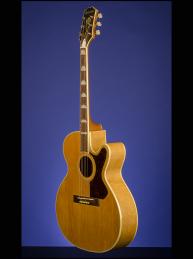Epiphone's More Deluxe Version of Gibson's J-200 - With a Cutaway Body
1956 Epiphone Deluxe Cutaway FT 210
This incredibly rare Epiphone Deluxe Cutaway weighs just 5.50 lbs. and has a 17 1/4 inch wide and 4 inch deep (down to 3 3/4 inches at neck end) one-piece 'lightly flamed' maple back and sides. Parallel-braced two-piece, multi-bound close-grained spruce top with a 3 5/8 inch diameter, nine-ply bound sound hole. The top and back of the body have six-ply white and black binding. Two-piece mahogany neck with a rosewood center-strip, a nice wide nut width of just over 1 11/16 inches, a scale length of 25 5/8 inches and a wonderful thick profile. Single-bound rosewood fretboard with three parallel lines (white/black/white) on each side. Twenty original medium frets, inlaid pearl 'Cloud' position markers and medium-small black side markers. Walnut faced headstock with inlaid pearl "Epiphone" and 'Flower' design. The headstock has three-ply white and black binding. Individual gold-plated Epiphone closed-back tuners with tulip-shaped Keystone plastic buttons. Bullet shaped white plastic truss-rod cover with single screw. Original specific-shaped tortoiseshell pickguard. Original 'unmolested' solid bone bridge on unique rectangular shaped rosewood tailpiece with six original white plastic bridge pins. Original white plastic heel-cap and white plastic strap-pin. Inside the sound-hole is the original rectangular white Epiphone New York label with "Model F.T. 210- Deluxe Cutaway" typed in black and the serial number "69624" also typed in black. This super-rare guitar is in near mint 9.25 condition with just some fine checking and a small indentation on the bass-side of the neck just behind the first fret. The action at the 12th fret is nice and low and the accessibility to the higher frets is really good due to the cutaway.
Measuring 17 3/8 inches across the widest part of its lower bout, the FT-210 Deluxe Cutaway is almost ½ inch wider than a Gibson J-200. It also has a carved, arched back that contributes to the guitar’s impressive volume output and projection. Jazz guitarist Harry Volpe often played an Epiphone FT-210 Deluxe Cutaway during the 1950s. "This was the only cutaway model flat-top guitar produced by Epiphone and was the top of the line model from 1954 to 1957. As with many Continental era instruments, specifications vary from catalog descriptions and one instrument to another." (Fisch & Fred, Epiphone. The House of Stathoupoulo, p. 273).
The production numbers for this guitar were tiny - and we have never seen another natural example.
"While Epiphone’s archtop guitar line would give Gibson a run for their money, the flat-top line was lacking in a guitar at the top of the food chain. Gibson’s big fancy J-200 model was the target to beat. The good folks at Epiphone decided their new model would be called the FT-210 (10 more than the J-200!) Deluxe Cutaway. The lower bout was a monsterous 17 3/8″ wide and the back and sides were curly Maple. The head stock and fretboard inlays could be spotted from a mile away. The cutaway added access to the fretboard that would accommodate a much wider range of playing styles. Sadly, management issues plagued the company during the 1950s and very few of these were built." (John Schults) http://truevintageguitar.com/1954-epiphone-ft-210-deluxe-cutaway-2/
"Deluxe Cutaway Flat-Top
Epiphone resurrected the “Deluxe” name for a flat-top with the 1964 introduction of the “Deluxe Cutaway Flat Top”, proudly proclaiming this to be the “finest flat top, round hole guitar ever offered”. This was one of Continental’s few innovative moves during their stewardship of Epiphone. The Deluxe Cutaway was a model favored in particular by guitarist Harry Volpe. Some examples of the Deluxe Cutaway Flat Top are labeled “Deluxe Regent”.
The Deluxe Cutaway Flat Top was rather like the 1939 De Luxe Flat Top, in that it mimicked the archtop De Luxe in many ways/ The Deluxe Cutaway Flat Top had a 17 3/8” body with a single rounded cutaway; a huge size for a flat-top instrument. The back, sides and neck were made from curly maple and the top was of close-grain spruce. Multi-ply binding appeared on the top and back; neck and headstock were single-ply bound in white. The center-dip peghead carried the script “Epiphone” pearl logo as well as the pearl tree-of-life inlay (though some featured the large flower inlay as found on the Broadway archtop) and a plastic truss-rod cover. The rosewood fingerboard had pearl cloud inlays (though some have been noted with a notched rectangle inlay) at frets one, three, five, seven, nine and twelve and a pearl rectangle at fret fifteen. The bottom edge of the fingerboard was curved to follow the outline of the soundhole. The tortoiseshell plastic pickguard extended from the edge of the bridge to follow the contour of the cutaway. The rosewood pin bridge had a compensated saddle of rosewood. Tuning gears were the fancy Epiphone plastic-button, individual enclosed machines in gold plate. The finish was offered in either natural or a full sunburst; top, back, sides and neck. Like its companion models (the F.T. 79 and F.T. 110) the F.T. Deluxe Cutaway featured a laminated Tone Back. This instrument was discontinued by 1957." (Fisch & Fred, Epiphone. The House of Stathoupoulo, p. 164).












